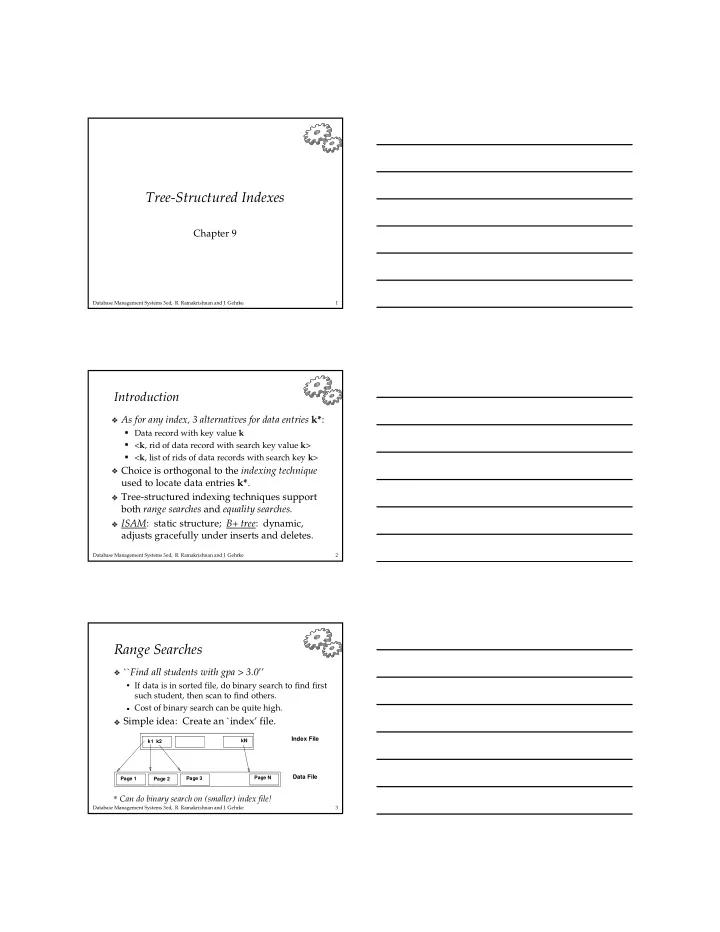

✂ ✁ � ✂ � � � ✁ � ✁ � Tree-Structured�Indexes Chapter�9 Database�Management�Systems�3ed,��R.�Ramakrishnan�and�J.�Gehrke 1 Introduction As�for�any�index,�3�alternatives�for�data�entries� k* : Data�record�with�key�value k < k ,�rid�of�data�record�with�search�key�value k > < k ,�list�of�rids�of�data�records�with�search�key� k > Choice�is�orthogonal�to�the� indexing�technique� used�to�locate�data�entries k* . Tree-structured�indexing�techniques�support� both� range�searches� and� equality�searches . ISAM :��static�structure; B+�tree :��dynamic,� adjusts�gracefully�under�inserts�and�deletes. Database�Management�Systems�3ed,��R.�Ramakrishnan�and�J.�Gehrke 2 Range�Searches `` Find�all�students�with gpa >�3.0 ’’ If�data�is�in�sorted�file,�do�binary�search�to�find�first� such�student,�then�scan�to�find�others. Cost�of�binary�search�can�be�quite�high. Simple�idea:��Create�an�`index’�file. Index�File kN k1 k2 Data�File Page�1 Page�3 Page�N Page�2 * Can�do�binary�search�on�(smaller)�index�file! Database�Management�Systems�3ed,��R.�Ramakrishnan�and�J.�Gehrke 3
� � � � � � � ISAM index�entry P0 K 1 P 1 K 2 P 2 K m P m Index�file�may�still�be�quite�large.��But�we�can� apply�the�idea�repeatedly! Non-leaf Pages Leaf Pages Overflow� page Primary�pages * Leaf�pages�contain�data�entries . Database�Management�Systems�3ed,��R.�Ramakrishnan�and�J.�Gehrke 4 Data� Comments�on�ISAM Pages Index�Pages File�creation :��Leaf�(data)�pages�allocated������������������ sequentially,�sorted�by�search�key;�then�index�������� pages�allocated,�then�space�for�overflow�pages. Overflow�pages Index�entries :��<search�key�value,�page�id>;��they��� `direct’�search�for� data�entries ,�which�are�in�leaf�pages. Search :��Start�at�root;�use�key�comparisons�to�go�to�leaf.�� ∝ Cost�����log� F� N�;�F�=�#�entries/index�pg,�N�=�#�leaf�pgs Insert :��Find�leaf�data�entry�belongs�to,�and�put�it�there. Delete :��Find�and�remove�from�leaf;�if�empty�overflow� page,�de-allocate.� * Static�tree�structure :�� inserts/deletes�affect�only�leaf�pages . Database�Management�Systems�3ed,��R.�Ramakrishnan�and�J.�Gehrke 5 Example�ISAM�Tree Each�node�can�hold�2�entries;�no�need�for� `next-leaf-page’�pointers.��(Why?) Root 40 20 33 51 63 46* 55* 10* 15* 20* 27* 33* 37* 40* 51* 63* 97* Database�Management�Systems�3ed,��R.�Ramakrishnan�and�J.�Gehrke 6
� � � After�Inserting�23*,�48*,�41*,�42*�... Root 40 Index Pages 20 33 51 63 Primary Leaf 46* 55* 10* 15* 20* 27* 33* 37* 40* 51* 63* 97* Pages 23* 48* 41* Overflow Pages 42* Database�Management�Systems�3ed,��R.�Ramakrishnan�and�J.�Gehrke 7 ...�Then�Deleting�42*,�51*,�97* Root 40 20 33 51 63 46* 55* 10* 15* 20* 27* 33* 37* 40* 63* 23* 48* 41* * Note�that�51*�appears�in�index�levels,�but��not�in�leaf! Database�Management�Systems�3ed,��R.�Ramakrishnan�and�J.�Gehrke 8 B+�Tree:�Most�Widely�Used�Index Insert/delete�at�log� F N�cost;�keep�tree� height- balanced .���(F�= fanout,�N�=�#�leaf�pages) Minimum�50%�occupancy�(except�for�root).��Each� node�contains� d <=�� m <=�2 d entries.��The� parameter� d is�called�the� order of�the�tree. Supports�equality�and�range-searches�efficiently. Index�Entries (Direct�search) Data�Entries ("Sequence�set") Database�Management�Systems�3ed,��R.�Ramakrishnan�and�J.�Gehrke 9
� � � � � � � � � � � � � � � � � � � Example�B+�Tree Search�begins�at�root,�and�key�comparisons� direct�it�to�a�leaf�(as�in�ISAM). Search�for�5*,�15*,�all�data�entries�>=�24*�... Root 30 13 17 24 2* 3* 5* 7* 14* 16* 19* 20* 22* 24* 27* 29* 33* 34* 38* 39* * Based�on�the�search�for�15*,�we�know it�is�not�in�the�tree! Database�Management�Systems�3ed,��R.�Ramakrishnan�and�J.�Gehrke 10 B+�Trees�in�Practice Typical�order:�100.��Typical�fill-factor:�67%. average�fanout�=�133 Typical�capacities: Height�4:�133 4 =�312,900,700�records Height�3:�133 3 =�����2,352,637�records Can�often�hold�top�levels�in�buffer�pool: Level�1�=�����������1�page��=�����8�Kbytes Level�2�=������133�pages�=�����1�Mbyte Level�3�=�17,689�pages�=�133�MBytes������� Database�Management�Systems�3ed,��R.�Ramakrishnan�and�J.�Gehrke 11 Inserting�a�Data�Entry�into�a�B+�Tree Find�correct�leaf� L. Put�data�entry�onto� L . If� L� has�enough�space,� done ! Else,�must� split L�(into�L�and�a�new�node�L2) • Redistribute�entries�evenly,� copy�up middle�key. • Insert�index�entry�pointing�to� L2� into�parent�of� L . This�can�happen�recursively To�split�index�node,�redistribute�entries�evenly,�but� push�up middle�key.��(Contrast�with�leaf�splits.) Splits�“grow”�tree;�root�split�increases�height.�� Tree�growth:�gets� wider or� one�level�taller�at�top. Database�Management�Systems�3ed,��R.�Ramakrishnan�and�J.�Gehrke 12
� � � � � � � � Inserting�8*�into�Example�B+�Tree Entry�to�be�inserted�in�parent�node. Observe�how� (Note�that�5�is s�copied�up�and 5 continues�to�appear�in�the�leaf.) minimum� occupancy�is� 2* 3* 5* 7* 8* guaranteed�in� both�leaf�and� index�pg�splits. Note�difference� Entry�to�be�inserted�in�parent�node. (Note�that�17�is�pushed�up�and�only between� copy- 17 appears�once�in�the�index.�Contrast this�with�a�leaf�split.) up and� push-up ;� be�sure�you� 5 13 24 30 understand�the� reasons�for�this. Database�Management�Systems�3ed,��R.�Ramakrishnan�and�J.�Gehrke 13 Example�B+�Tree�After�Inserting�8* Root 17 24 5 13 30 2* 3* 5* 7* 8* 14* 16* 19* 20* 22* 24* 27* 29* 33* 34* 38* 39* v Notice�that�root�was�split,�leading�to�increase�in�height. v In�this�example,�we�can�avoid�split�by�re-distributing������������� entries;�however,�this�is�usually�not�done�in�practice. Database�Management�Systems�3ed,��R.�Ramakrishnan�and�J.�Gehrke 14 Deleting�a�Data�Entry�from�a�B+�Tree Start�at�root,�find�leaf� L where�entry�belongs. Remove�the�entry. If�L�is�at�least�half-full,� done!� If�L�has�only� d-1� entries, • Try�to�re-distribute,�borrowing�from� sibling (adjacent� node�with�same�parent�as�L) . • If�re-distribution�fails,� merge L� and�sibling. If�merge�occurred,�must�delete�entry�(pointing�to� L or�sibling)�from�parent�of� L . Merge�could�propagate�to�root,�decreasing�height. Database�Management�Systems�3ed,��R.�Ramakrishnan�and�J.�Gehrke 15
� � � � � � Example�Tree�After�(Inserting�8*,� Then)�Deleting�19*�and�20*�... Root 17 5 13 27 30 2* 3* 5* 7* 8* 22* 24* 27* 29* 33* 34* 38* 39* 14* 16* Deleting�19*�is�easy. Deleting�20*�is�done�with�re-distribution.� Notice�how�middle�key�is� copied�up . Database�Management�Systems�3ed,��R.�Ramakrishnan�and�J.�Gehrke 16 ...�And�Then�Deleting�24* Must�merge. 30 Observe�` toss ’�of� index�entry�(on�right),� 39* 22* 27* 29* 33* 34* 38* and�` pull�down ’�of� index�entry�(below). Root 5 13 17 30 2* 3* 5* 7* 8* 22* 27* 33* 34* 38* 39* 14* 16* 29* Database�Management�Systems�3ed,��R.�Ramakrishnan�and�J.�Gehrke 17 Example�of�Non-leaf�Re-distribution Tree�is�shown�below� during�deletion� of�24*.�(What� could�be�a�possible�initial�tree?) In�contrast�to�previous�example,�can�re-distribute� entry�from�left�child�of�root�to�right�child.�� Root 22 30 5 13 17 20 2* 3* 5* 7* 8* 14* 16* 17* 18* 20* 21* 22* 27* 29* 33* 34* 38* 39* Database�Management�Systems�3ed,��R.�Ramakrishnan�and�J.�Gehrke 18
Recommend
More recommend